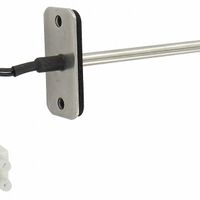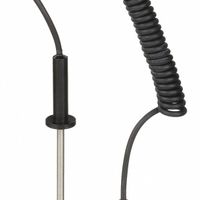Call +(254) 703 030 000 / 751 483 999 / 721 704 777
- Home
- Test Instruments
- Temperature And Environmental Measurement
- Temperature Probes Components
- Long Life High Accuracy Rtd Probes
.....Read More
Frequently Asked Questions
What is the difference between RTD and PRT probes?
RTD (Resistance Temperature Detector) and PRT (Platinum Resistance Thermometer) probes are both types of temperature sensors that operate on the principle of resistance change with temperature. However, there are key differences between them:
1. **Material**:
- RTD probes can be made from various metals, including platinum, nickel, or copper.
- PRT probes specifically use platinum, which is preferred for its stability and linearity over a wide temperature range.
2. **Temperature Range**:
- RTDs generally cover a broad temperature range, but the specific range depends on the material used.
- PRTs, being a type of RTD, typically operate effectively from -200°C to 850°C, leveraging platinum's properties.
3. **Accuracy and Stability**:
- RTDs, in general, offer high accuracy and stability, but this can vary with the material.
- PRTs are known for their superior accuracy and long-term stability, making them ideal for precision applications.
4. **Linearity**:
- RTDs have a relatively linear resistance-temperature relationship, but this can vary with different metals.
- PRTs exhibit excellent linearity, which simplifies calibration and measurement.
5. **Cost**:
- RTDs can vary in cost depending on the material and construction.
- PRTs are typically more expensive due to the cost of platinum and their precision manufacturing requirements.
6. **Applications**:
- RTDs are used in various applications, from industrial to scientific, depending on the material.
- PRTs are often used in laboratory and industrial settings where high precision and reliability are crucial.
In summary, while all PRTs are RTDs, not all RTDs are PRTs. PRTs are a specialized, high-precision subset of RTDs, distinguished by their use of platinum.
How do you install a direct-connect RTD probe?
1. **Select the Location**: Choose an appropriate location for the RTD probe where it can accurately measure the temperature. Ensure it is away from any potential sources of interference or damage.
2. **Prepare the Installation Site**: Clean the area where the RTD will be installed. If necessary, drill a hole or use an existing port that matches the size of the RTD probe.
3. **Insert the Probe**: Carefully insert the RTD probe into the designated location. If using a thermowell, ensure the probe fits snugly inside. The probe should be fully immersed in the medium for accurate readings.
4. **Secure the Probe**: Use appropriate fittings or clamps to secure the RTD probe in place. Ensure it is tightly sealed to prevent any leaks or movement.
5. **Connect the Wiring**: Identify the RTD wires, typically two, three, or four wires. Connect these wires to the corresponding terminals on the temperature transmitter or control system. Ensure proper connections to avoid measurement errors.
6. **Check the Connections**: Verify that all electrical connections are secure and correct. Use a multimeter to check for continuity and ensure there are no short circuits.
7. **Calibrate the System**: If necessary, calibrate the RTD probe with the control system to ensure accurate temperature readings. Follow the manufacturer’s instructions for calibration procedures.
8. **Test the Installation**: Power on the system and monitor the temperature readings. Compare them with a known reference to ensure accuracy.
9. **Secure and Protect**: Once confirmed, secure all connections and protect the wiring from environmental factors such as moisture, heat, or mechanical damage.
10. **Document the Installation**: Record the installation details, including the location, type of RTD, and any calibration data for future reference and maintenance.
What are the advantages of using a threaded RTD probe?
Threaded RTD (Resistance Temperature Detector) probes offer several advantages:
1. **Secure Installation**: The threaded design ensures a secure and stable installation, reducing the risk of movement or dislodgement during operation. This is particularly beneficial in environments with vibrations or fluid flow.
2. **Easy Maintenance and Replacement**: Threaded connections allow for easy removal and replacement of the RTD probe without the need for specialized tools, minimizing downtime during maintenance.
3. **Leak Prevention**: The threaded connection provides a tight seal, which is crucial in preventing leaks in pressurized systems or when measuring temperatures in liquids and gases.
4. **Versatility**: Threaded RTD probes are available in various thread sizes and materials, making them suitable for a wide range of applications and compatible with different types of equipment and environments.
5. **Durability**: The robust construction of threaded RTD probes makes them durable and capable of withstanding harsh conditions, including high pressure and temperature extremes.
6. **Accurate Temperature Measurement**: RTDs are known for their high accuracy and stability over a wide temperature range, and the secure installation of threaded probes ensures consistent and reliable readings.
7. **Wide Application Range**: These probes can be used in various industries, including chemical processing, food and beverage, HVAC, and pharmaceuticals, due to their adaptability and reliability.
8. **Cost-Effectiveness**: The ease of installation and maintenance, combined with the durability and reliability of threaded RTD probes, can lead to cost savings over time by reducing the need for frequent replacements and repairs.
9. **Customizability**: Threaded RTD probes can be customized in terms of length, diameter, and material to meet specific application requirements, enhancing their utility across different sectors.
How do you calibrate an RTD probe for accuracy?
To calibrate an RTD (Resistance Temperature Detector) probe for accuracy, follow these steps:
1. **Preparation**: Ensure the RTD and calibration equipment are clean and in good working condition. Gather necessary tools, including a calibrated temperature source (like a dry block or liquid bath), a precision multimeter or resistance bridge, and reference temperature standards.
2. **Stabilization**: Allow the RTD and calibration equipment to stabilize at room temperature to avoid initial temperature fluctuations affecting the readings.
3. **Connection**: Connect the RTD to the multimeter or resistance bridge. Use a 3-wire or 4-wire connection to minimize lead resistance errors.
4. **Calibration Points**: Select calibration points across the RTD's operating range, typically including the minimum, midpoint, and maximum temperatures.
5. **Reference Temperature**: Immerse the RTD and a reference thermometer in the temperature source. Ensure both are at the same depth and have good thermal contact.
6. **Equilibration**: Allow sufficient time for the RTD and reference thermometer to reach thermal equilibrium at each calibration point.
7. **Measurement**: Record the resistance or temperature reading from the RTD and compare it with the reference thermometer's reading. Note any discrepancies.
8. **Adjustment**: If discrepancies are found, adjust the RTD's output using its calibration settings or document the deviation for correction in measurements.
9. **Repeat**: Repeat the process for all selected calibration points to ensure accuracy across the entire range.
10. **Documentation**: Record all readings, adjustments, and conditions during calibration for future reference and traceability.
11. **Verification**: After calibration, verify the RTD's performance by checking additional points or using it in a controlled environment to ensure consistent accuracy.
12. **Recalibration Schedule**: Establish a regular recalibration schedule based on the RTD's usage and environmental conditions to maintain accuracy over time.
What applications are suitable for flex-wire RTD probes?
Flex-wire RTD probes are suitable for applications requiring precise temperature measurements in environments where flexibility and adaptability are crucial. These applications include:
1. **HVAC Systems**: Used for monitoring and controlling temperature in heating, ventilation, and air conditioning systems due to their flexibility and accuracy.
2. **Automotive Industry**: Ideal for measuring temperatures in engines, exhaust systems, and other components where space is limited and flexibility is needed.
3. **Aerospace**: Suitable for temperature monitoring in aircraft systems, where lightweight and flexible sensors are essential.
4. **Food and Beverage Processing**: Used in environments where hygiene and precise temperature control are critical, such as in ovens, freezers, and processing lines.
5. **Pharmaceuticals**: Essential for maintaining strict temperature controls in drug manufacturing and storage, ensuring product efficacy and safety.
6. **Chemical Processing**: Suitable for use in reactors and pipelines where corrosive environments and high temperatures are present.
7. **Power Generation**: Used in turbines, generators, and other equipment where accurate temperature monitoring is crucial for efficiency and safety.
8. **Laboratory and Research**: Ideal for experimental setups requiring precise and flexible temperature measurement solutions.
9. **Marine Applications**: Used in ship engines and other marine systems where space constraints and harsh conditions are common.
10. **Renewable Energy**: Suitable for monitoring temperatures in solar panels, wind turbines, and other renewable energy systems to optimize performance.
11. **Medical Equipment**: Used in devices like incubators and sterilizers where precise temperature control is vital.
12. **Electronics and Semiconductors**: Essential for temperature monitoring in manufacturing processes where precision is critical to product quality.
Flex-wire RTD probes are chosen for their ability to provide accurate, reliable temperature readings in challenging environments where traditional rigid sensors may not be feasible.
How do you ensure the long-term stability of an RTD probe?
To ensure the long-term stability of an RTD (Resistance Temperature Detector) probe, consider the following:
1. **Material Selection**: Use high-quality materials like platinum for the sensing element due to its stability and repeatability. Ensure the protective sheath is made from corrosion-resistant materials like stainless steel or Inconel.
2. **Calibration**: Regularly calibrate the RTD against a standard to maintain accuracy. Use traceable calibration standards and document the process.
3. **Installation**: Properly install the RTD to avoid mechanical stress. Ensure it is securely mounted and protected from vibration and physical damage.
4. **Environmental Protection**: Protect the RTD from harsh environmental conditions. Use appropriate insulation and sealing to prevent moisture ingress and chemical exposure.
5. **Temperature Range**: Operate the RTD within its specified temperature range to prevent drift and degradation. Avoid thermal shock by allowing gradual temperature changes.
6. **Wiring and Connections**: Use high-quality, low-resistance wiring and ensure secure connections to minimize electrical noise and resistance changes.
7. **Regular Maintenance**: Implement a maintenance schedule to inspect and clean the RTD. Check for signs of wear, corrosion, or damage.
8. **Signal Conditioning**: Use proper signal conditioning equipment to filter noise and amplify the signal, ensuring accurate readings.
9. **Redundancy**: In critical applications, use redundant RTDs to cross-verify readings and ensure reliability.
10. **Documentation**: Keep detailed records of installation, calibration, and maintenance activities to track performance over time.
By following these practices, you can enhance the long-term stability and reliability of an RTD probe.
What certifications are required for food and pharmaceutical RTD probes?
For food and pharmaceutical RTD (Resistance Temperature Detector) probes, several certifications and standards are typically required to ensure safety, accuracy, and compliance with industry regulations:
1. **FDA Compliance**: In the United States, RTD probes used in food and pharmaceuticals must comply with the Food and Drug Administration (FDA) regulations, ensuring they are safe for use in contact with food and drugs.
2. **3-A Sanitary Standards**: For food applications, RTD probes often need to meet 3-A Sanitary Standards, which ensure that the equipment is designed for easy cleaning and prevents contamination.
3. **EHEDG Certification**: The European Hygienic Engineering & Design Group (EHEDG) certification is important for equipment used in food processing to ensure hygienic design and cleanability.
4. **USP Class VI**: In pharmaceutical applications, materials used in RTD probes may need to meet United States Pharmacopeia (USP) Class VI standards, which test for biocompatibility and ensure that materials do not leach harmful substances.
5. **ISO 9001**: Manufacturers of RTD probes often need ISO 9001 certification, which ensures that they have a quality management system in place to consistently produce products that meet customer and regulatory requirements.
6. **NIST Traceability**: RTD probes should be calibrated and traceable to the National Institute of Standards and Technology (NIST) to ensure measurement accuracy and reliability.
7. **ATEX/IECEx Certification**: For use in potentially explosive environments, such as certain pharmaceutical manufacturing areas, RTD probes may require ATEX or IECEx certification to ensure they are safe to use in such conditions.
8. **RoHS Compliance**: Ensures that the probes are free from hazardous substances, aligning with the Restriction of Hazardous Substances Directive.
These certifications and standards help ensure that RTD probes are safe, reliable, and suitable for use in sensitive food and pharmaceutical environments.




